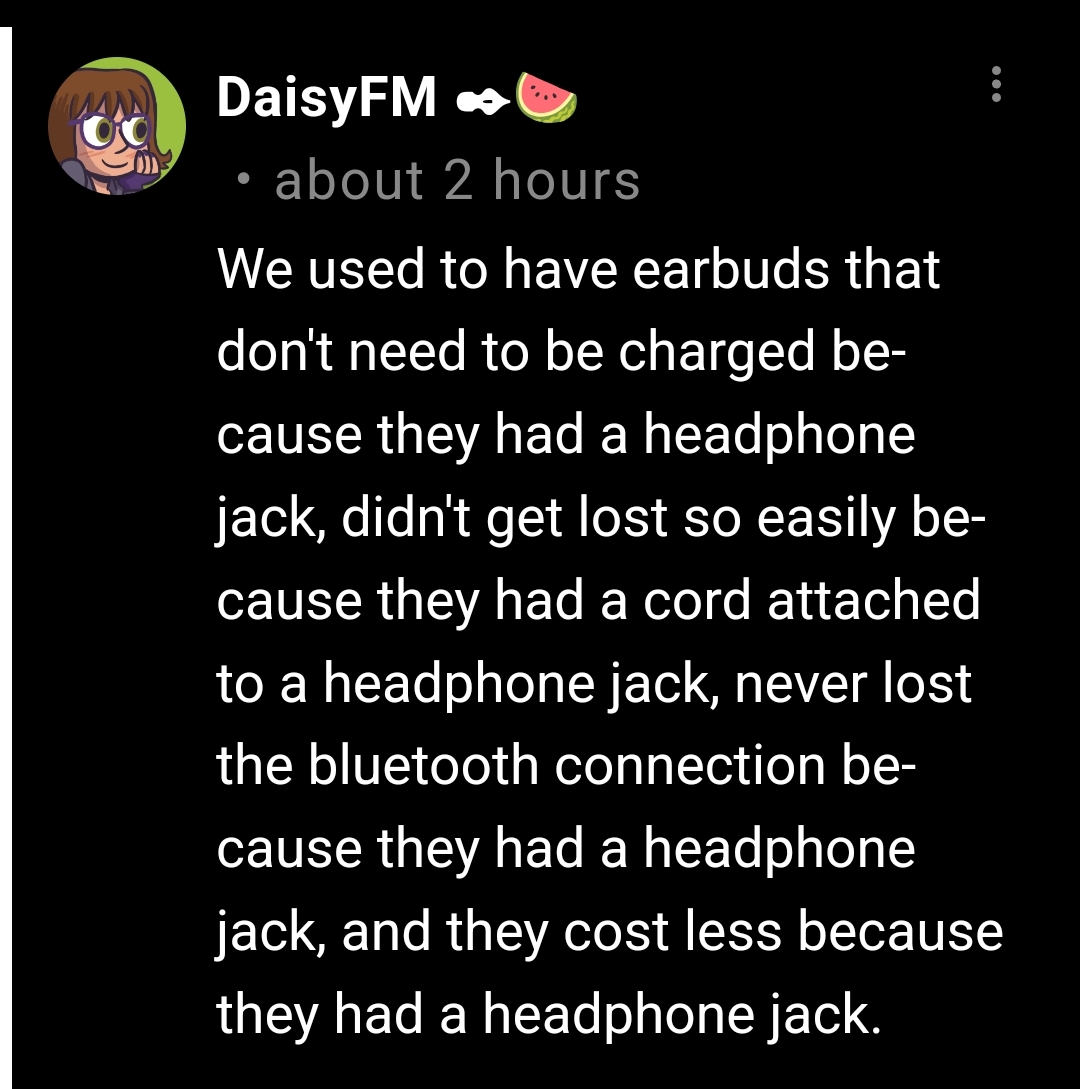this post was submitted on 08 Sep 2024
1624 points (95.3% liked)
Microblog Memes
5388 readers
2327 users here now
A place to share screenshots of Microblog posts, whether from Mastodon, tumblr, ~~Twitter~~ X, KBin, Threads or elsewhere.
Created as an evolution of White People Twitter and other tweet-capture subreddits.
Rules:
- Please put at least one word relevant to the post in the post title.
- Be nice.
- No advertising, brand promotion or guerilla marketing.
- Posters are encouraged to link to the toot or tweet etc in the description of posts.
Related communities:
founded 1 year ago
MODERATORS
you are viewing a single comment's thread
view the rest of the comments
view the rest of the comments

I didn't believe the hype about wireless headphones until I bought some with noise cancelling and all that for around $130.
Pros:
1 - You don't realize how "tethered" you feel on older headphones until you really try to use wireless headphones. There's a certain freedom you feel when you realize you can place your phone on a hotel table but lie down in bed.
2 - Noise cancelling and noise passthrough is a transformative experience when travelling or find yourself abroad. Airports are much easier to feel relaxed in when 80% of the noise or so can be filtered out as you wait for your flight to board. Additionally, the flight experience is less annoying (no engine drone gets through, even passengers can mostly be ignored) but you still have the option for pass through if someone absolutely needs to talk to you.
3 - Many of these headphones come with some kind of EQ feature, which can occasionally mean that you get speakers with more tunability and thus slightly better bang-for-buck that works globally across apps.
4 - Audio quality. Since these are expensive drivers, you're often going to get better sound quality than those cheap 30 dollar throw aways were ever going to give.
Cons:
1 - Latency. These things could never be used in professional audio situations other than listening to a pre-rendered song for quality judgements. I don't thing gaming would be nice with these either, even if I've tried (and failed) to play counter strike on these on occasion to keep noise levels down.
2 - Mic quality of the built in is lacking on my particular headphones (Sennheiser CX Plus). They're really only intended to capture the outdoor for noise cancellation IMO, not the greatest for calls or recordings. They're servicable, but it's the area I'd like the most upgrade (and it would probably improve noise cancellation features as well.)
3 - Environmental / Sustainability Concerns: Other than people just "losing" these devices with built in batteries that are bad for the environment being a problem in and of itself, there are other long-standing concerns I have about these devices. They often require proprietary non-open software to configure, meaning if the software gets delisted, you will no longer be able to configure them until someone comes up with some kind of alternative using reverse engineering (good luck). Batteries are likely to degrade over time, meaning you'll eventually end up with a worthless ear bud on the left or right and the only solution will be to throw them out. These things are often pretty bad scoring on repairability metrics, and I can't even blame the companies producing them here because they're so small.
4 - Despite passthrough being a feature, it's hard to convey to people that you can actually hear them through the device. There should be some kind of blinking light on the outside that indicates that passthrough is enabled or something.
So I actually do love these devices, but #3 of the cons is really the biggest real issue I have with them. If they're going to cost over 100 dollars, I would like to know that these things won't just become ewaste in the same way that cheap crappy wired headphones end up being as well (which sea life often chokes on or gets tangled up in.) If they costs a premium, I would really like to know that they aren't a figurative dead end when they eventually fail.
4 - Audio quality. Since these are expensive drivers, you’re often going to get better sound quality
Heheheheheheh
No.
Bluetooth bitrate is like 328kbps, which is absolute and total garbage mp3 quality. If you're on Bluetooth, you aren't even getting CD quality. We're going backwards so far.
It’s a bit more complicated than that. There are multiple codecs available (some with much higher bitrates), but even in AAC (which I assume you are referring to) there are different implementations. Also note that 328kbps is not “garbage mp3”, 128kbps CBR was the common (and shit) variant that you probably meant. But more modern codecs achieve much better fidelity at lower bitrates even.
328kbps is absolutely horrid and nowhere close to CD quality (1411 kbps). Good quality audio is over 6000 kbps.
328kbps in a lossy format is plenty. You might be one of those people who claim to hear the difference, but to date we are yet to see a double blind trial where a substantial percentage of individuals reliably could demonstrate such ability.
328 kbps is nowhere near enough. 1411 kbps .wav is the minimum I'll listen to, even on my phone.
24 bit 96kHz is optimal, but I can't hear any difference going higher than that.